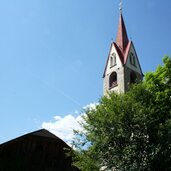The small hamlet is known for its hydroelectric power station and the noteworthy St. Margaret’s Church
Image gallery: Kniepass
Kniepass, with its St. Margaret's Church, is situated on a hill off the road in the lower part of the Val Pusteria, towards the Valle Isarco. Although the hamlet is small, the name Kniepass may be familiar to many. Drivers will know it from the winding section of the Val Pusteria state road, while locals recognise it primarily for the hydroelectric power station on the Rienza River. This facility uses the gradient between the main village of San Lorenzo and Kniepass to generate electricity.
Among the scattered farmsteads stands the Gothic village church with its fresco resembling a Lenten veil and its small altar. It is dedicated to St. Margaret of Antioch, who is counted among the Fourteen Holy Helpers and the "Virgines capitales", the great virgins.
A legend tells of "St. Margareta am Kniebos": In a deep, remote cave, the image of Saint Margaret was supposedly found under mysterious circumstances, which led to the decision to build a church for the saint on this site. It was constructed in 1400 by Heinrich Stadler of the Stadelhof farm in Campolino. In gratitude, he and his wife are immortalised in knightly attire behind the church door.
Today, Kniepass is also known for its walking trails. From here, you can reach the neighbouring municipality of Chienes as well as Campolino and Castelbadia, two hamlets that also belong to San Lorenzo di Sebato. These are meadow walks that do not require great effort and transform into peaceful winter hiking trails during the colder months.
























